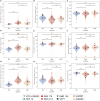Interspecific common bean population derived from Phaseolus acutifolius using a bridging genotype demonstrate useful adaptation to heat tolerance
- PMID: 37293677
- PMCID: PMC10246688
- DOI: 10.3389/fpls.2023.1145858
Interspecific common bean population derived from Phaseolus acutifolius using a bridging genotype demonstrate useful adaptation to heat tolerance
Abstract
Common bean (Phaseolus vulgaris L.) is an important legume crop worldwide and is a major nutrient source in the tropics. Common bean reproductive development is strongly affected by heat stress, particularly overnight temperatures above 20°C. The desert Tepary bean (Phaseolus acutifolius A. Gray) offers a promising source of adaptative genes due to its natural acclimation to arid conditions. Hybridization between both species is challenging, requiring in vitro embryo rescue and multiple backcrossing cycles to restore fertility. This labor-intensive process constrains developing mapping populations necessary for studying heat tolerance. Here we show the development of an interspecific mapping population using a novel technique based on a bridging genotype derived from P. vulgaris, P. Acutifolius and P. parvifolius named VAP1 and is compatible with both common and tepary bean. The population was based on two wild P. acutifolius accessions, repeatedly crossed with Mesoamerican elite common bush bean breeding lines. The population was genotyped through genotyping-by-sequencing and evaluated for heat tolerance by genome-wide association studies. We found that the population harbored 59.8% introgressions from wild tepary, but also genetic regions from Phaseolus parvifolius, a relative represented in some early bridging crosses. We found 27 significative quantitative trait loci, nine located inside tepary introgressed segments exhibiting allelic effects that reduced seed weight, and increased the number of empty pods, seeds per pod, stem production and yield under high temperature conditions. Our results demonstrate that the bridging genotype VAP1 can intercross common bean with tepary bean and positively influence the physiology of derived interspecific lines, which displayed useful variance for heat tolerance.
Keywords: genome wide association study (GWAS); heat tolerance; interspecific; introgression analysis; phaseolus acutifolius (tepary bean); yield.
Copyright © 2023 Cruz, Lobatón, Urban, Ariza-Suarez, Raatz, Aparicio, Mosquera and Beebe.
Conflict of interest statement
The authors declare that the research was conducted in the absence of any commercial or financial relationships that could be construed as a potential conflict of interest.
Figures






Similar articles
-
Physiological Characteristics of Cultivated Tepary Bean (Phaseolus acutifolius A. Gray) and Its Wild Relatives Grown at High Temperature and Acid Soil Stress Conditions in the Amazon Region of Colombia.Plants (Basel). 2021 Dec 31;11(1):116. doi: 10.3390/plants11010116. Plants (Basel). 2021. PMID: 35009119 Free PMC article.
-
Large genomic introgression blocks of Phaseolus parvifolius Freytag bean into the common bean enhance the crossability between tepary and common beans.Plant Direct. 2022 Dec 13;6(12):e470. doi: 10.1002/pld3.470. eCollection 2022 Dec. Plant Direct. 2022. PMID: 36523608 Free PMC article.
-
First use of microsatellite markers in a large collection of cultivated and wild accessions of tepary bean (Phaseolus acutifolius A. Gray).Theor Appl Genet. 2012 Oct;125(6):1137-47. doi: 10.1007/s00122-012-1900-0. Epub 2012 Jun 8. Theor Appl Genet. 2012. PMID: 22678667
-
Tepary bean (Phaseolus acutifolius).Methods Mol Biol. 2006;343:407-14. doi: 10.1385/1-59745-130-4:407. Methods Mol Biol. 2006. PMID: 16988363 Review.
-
Genomics, genetics and breeding of common bean in Africa: A review of tropical legume project.Plant Breed. 2019 Aug;138(4):401-414. doi: 10.1111/pbr.12573. Epub 2018 Apr 17. Plant Breed. 2019. PMID: 31728074 Free PMC article. Review.
Cited by
-
Genetic differentiation of a southern Africa tepary bean (Phaseolus acutifolius A Gray) germplasm collection using high-density DArTseq SNP markers.PLoS One. 2023 Dec 14;18(12):e0295773. doi: 10.1371/journal.pone.0295773. eCollection 2023. PLoS One. 2023. PMID: 38096255 Free PMC article.
References
-
- Aparicio J., Ariza-suarez D., Raatz B. (2019) Web application for spatial modelling of field trials aplicación web para la modelación espacial de ensayos de campo. Available at: https://hdl.handle.net/10568/103767.
-
- Assefa T., Rao I. M., Cannon S. B., Wu J., Gutema Z., Blair M., et al. (2017). Improving adaptation to drought stress in white pea bean (Phaseolus vulgaris l.): genotypic effects on grain yield, yield components and pod harvest index. Plant Breed. 136 (4), 548–561. doi: 10.1111/PBR.12496 - DOI
-
- Barrera S., Mier Y Teran J. C. B., Lobaton J. D., Escobar R., Gepts P., Beebe S., et al. (2022). Large Genomic introgression blocks of phaseolus parvifolius freytag bean into the common bean enhance the crossability between tepary and common beans. Plant Direct 6 (12), e470. doi: 10.1002/PLD3.470 - DOI - PMC - PubMed
-
- Beebe S. (2012). Common bean breeding in the tropics. Plant Breed. Rev. 36, 357–426. doi: 10.1002/9781118358566.ch5 - DOI
-
- Beebe S., Ramirez J., Jarvis A., Rao I. M., Mosquera G., Bueno J. M., et al. (2011). “Genetic improvement of common beans and the challenges of climate change” in Crop Adaptation to Climate Change. Eds Yadav S. S., Redden R. J., Hatfield J. L., Lotze-Campen H., Hall A. E.. 356–369.
LinkOut - more resources
Full Text Sources

